Think you can handle a traditional winter expedition trekking through the snow and ice for hours on end?
There’s a lot of work involved. Winter trekking is tough and challenging enough, but the real work begins when you get to camp.
After 8 hours of snowshoeing across frozen rivers, lakes, and historic trails, we had three hours a night of setting up camp to prepare for bed.
Our day of work is 13.5 hours, Welcome to your extreme vacation with Lure of the North.
These guys are so hard core, co-owner Kielyn Marrone finished in the top 3 finalists of Alone Season 7! She spent 80 days alone in the Arctic.
We spent 10 days up in the Arctic Watershed facing temperatures of 30 below. It sounds a little crazy doesn’t it? But as we always say, if we can do it, you can too!
Here’s a breakdown of what a typical day of Traditional Winter Camping and Trekking is like with The Lure of the North’s Missinaibi Headwaters Expeditions.
Table of Contents
Winter Expedition in Northern Canada
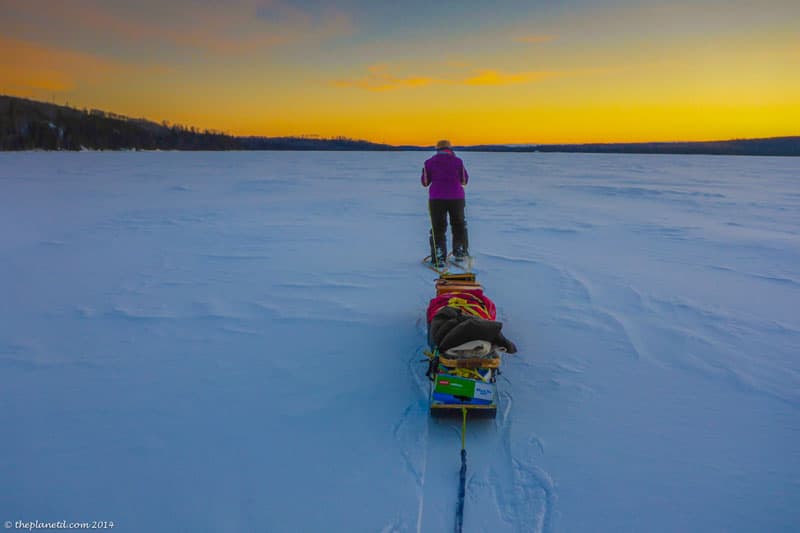
There wasn’t a chalet with fireplace waiting for us, there wasn’t a warm and cozy yurt to crawl into, and there wasn’t a nope, we had to prepare our sleeping arrangements for the night before we could settle.
Once we finished a day of trekking, we had just enough time to set up camp, eat our dinner and head to bed.
And then, after 8 hours of sleeping, we were up before dawn at 5:00 am to take another 3 hours to tear down camp.
We then set off to our next destination 10 km overland where we faced challenges of hoisting our sleds and gear up steep hills and uneven trails, avoiding thin ice and slush and dealing with fatigue and cold.
Morning 2.5 hours
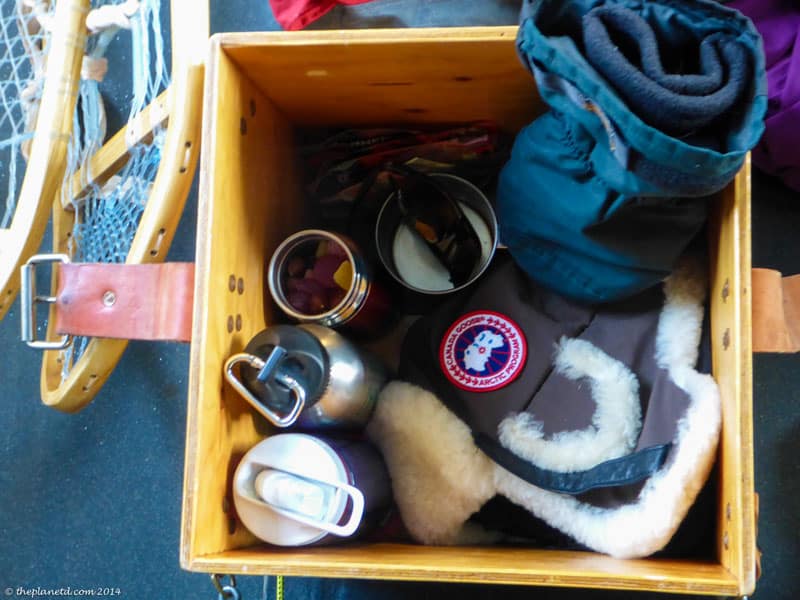
5:00 am wake up/coffee…if you are up for it. Dave and I never drank it. Water only for us!
5:15 – Pack up sleeping gear. Stuff sleeping bags away, roll up thermarests and load up our personal boxes.
5:30 – scrape ice off sleds
6:00 – Breakfast
6:15 – Toilet Break – consisting of putting on snowshoes, packing out a trail to the woods, configuring yourself so that you don’t poop on your snowshoes then, lighting the toilet paper so nothing is left. Going to the toilet was a huge and involved effort.
6:30 am pack sleds. Putting everything inside duffel bags and then putting bags and gear inside an outer bag and then strapping it all down with ratchet straps.
6:45 – Take down the tent – This took all of us. We’d have to break apart the poles which were completely frozen. Most of the time they were too frozen to detach so we had to heat them over a flame before we could break them down.
7:15 – spread boughs – We slept on a bed of Spruce boughs taken from tree branches. (they insulated us from the snow beautifully) In the morning we had to spread them around the camp so that there wouldn’t be a raft of branches when the Spring thaw came.
7:30 – Depart
Traditional Winter Trekking – 8hour Days
7:30 am to 3:30 pm Endless Trekking – 8hours and 10 km snowshoe trek from camp to camp.
Snowshoeing for eight hours pulling a hundred pound sled through various obstacles was not easy.
Portages
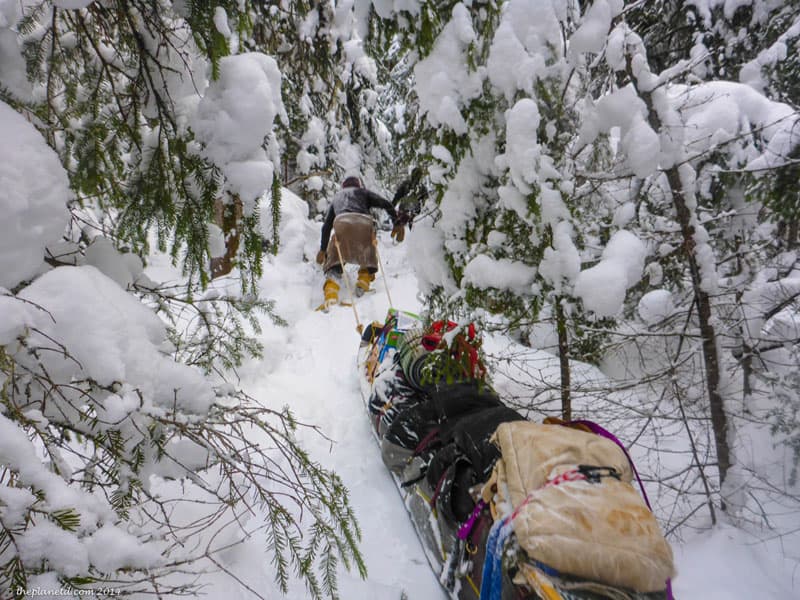
A day consisted of walking along a windswept lake to a portage. (A portage is a land connection between bodies of water.)
Portages start with steep hills where we may need to use ropes to pull up the sled up or work together as a team with two or three people hoisting the sled from in front and two or three people pushing from the back.
Someone goes ahead to clear the trail by packing the snow and cutting down fallen trees, while others move the sleds.
Most portages end in a steep downhill where we can ride our sleds down or hold on to the tail. It was a lot of effort, but the reward at the end was always a huge payoff.
Portages are slow and difficult and it can take 1 hour to walk 1 km.
But for some reason, we all loved the portages more than anything. When you came to the end of a really tough portage, you felt great!
Deep Snow
Each day we encountered deep snow where someone walked ahead of the group breaking trail as people follow in line.
Sometimes breaking trail was easier on a windswept lake, sometimes it was nearly impossible when trekking through knee-deep snow.
Thin Ice
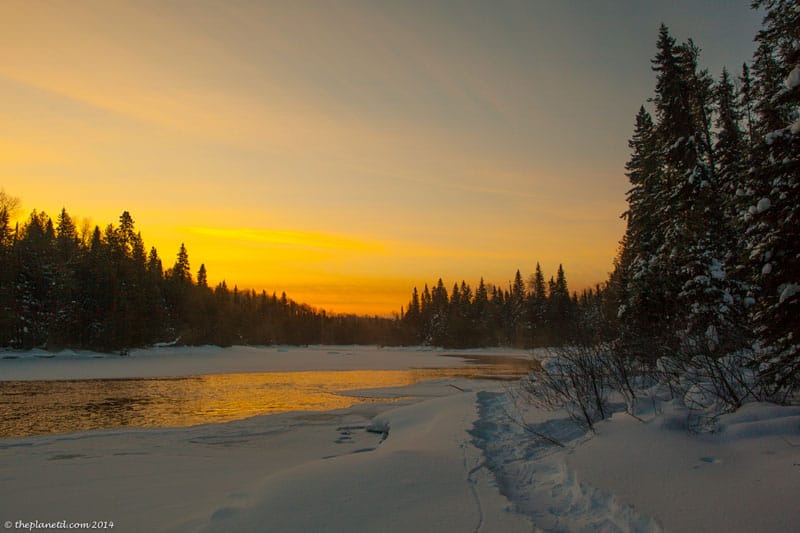
There are obstacles everywhere during the 100km trek, like thin ice. When we come to a narrow in the lake or a river we had to be aware of the possibility of thin ice.
Kielyn or Dave (owners and guides) would walk in front using their pole to check the ice by tapping it on the ground.
We had a total of 4 punch throughs and 1 break though. It happened at mostly at transitions where water meets up with the land.
Thin ice was also more of a possibility when walking on creeks and rivers due to moving water.
Moving water doesn’t freeze as opposed to lake water that is still.
Slush

Slush is another problem that can severely affect our time.
Slush is formed on the top of the ice by heavy snowfalls that have settled into the surface.
You don’t know you are walking through slush until you are already in the middle of it because it hides under a blanket of snow.
But soon, slush seeps up through the snow and instantly sticks to your snowshoes.
Once the snowshoes and sleds hit the ice, they freeze. Everything sticks to them and you can easily have 3 inches of ice build up on your shoes.
We had some very severe slush encounters that really set our schedule back each day.
It’s slow and miserable walking through ice and then you have to quickly work to get it off your shoes and sleds or else you won’t be able to walk.
The slush freezes and keeps picking up more slush making your snowshoes feel like lead.
2 to 3 breaks per day
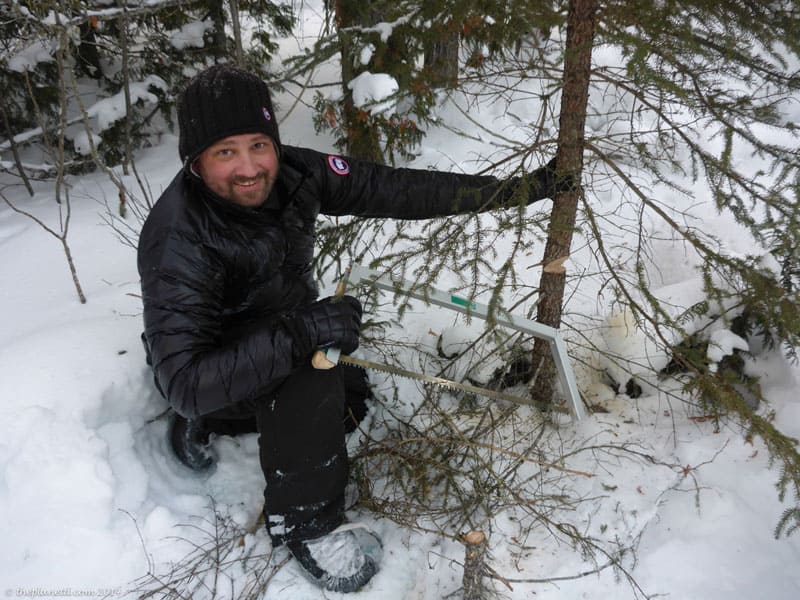
Soup and Tea breaks, and lunch breaks happen right on the lake or river.
We look for a spot sheltered from the wind and break out the food that Kielyn keeps in her insulated bags. Lunch is warm sandwiches, 1 meat and 1 Nutella or honey sandwich.
We have soup, chocolate bars, granola bars, tea and an entire snack bottle filled with delicious goodies like nuts, gummy bears and Easter eggs.
It was delicious!
Difficulties
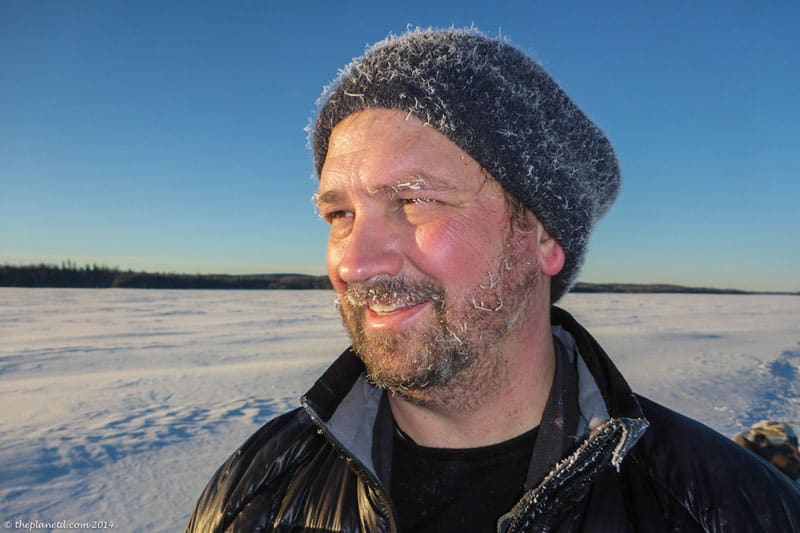
The day is spent severely sweating one minute and then freezing the next. You bundle up to try to get warm before you start moving again, and then once you start walking again, you perspire all over again.
It’s a vicious circle and it’s uncomfortable. You are hot, but it’s anywhere between 16 and 30 below zero, so you are cold at the same time, you feel the chill on your back, cheeks, and nose, but your core is hot. It is a strange feeling indeed.
3:30 begin to look for a camp. Dave and Kielyn begin to keep an eye out for a sheltered location with good ice to set up our camp for the night.
4:00 Take a 5 or 10 minute break to have some water, warm up and eat some snacks before the set up begins.
Camp Set Up 3 Hrs
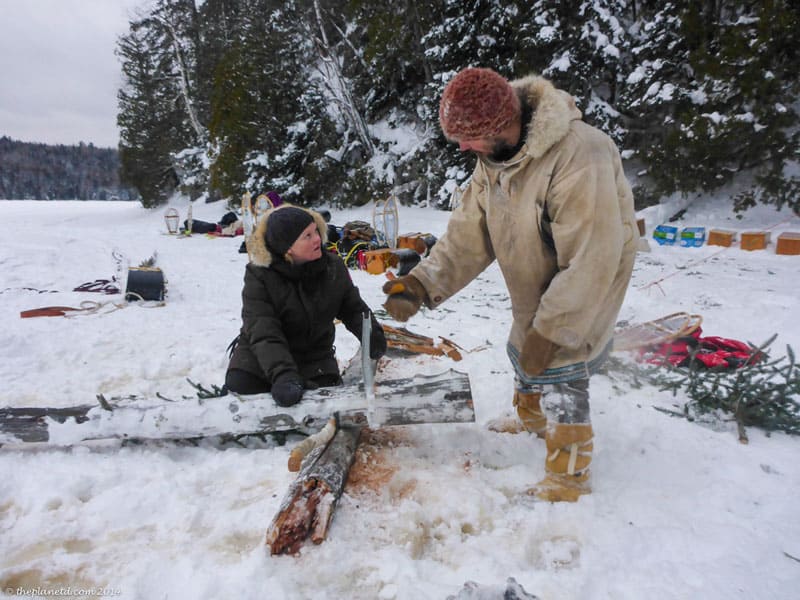
Camp set up starts with stomping down the snow all around camp so we can set up the tent, store our gear, food boxes and sleds and walk around in relative comfort.
After an area of snow is flattened with our snowshoes, 6 people from the group get together to put up the canvas tent, before breaking off on their various tasks.
There were only 7 of us on the expedition so it was the regular 6 people, while Dave Marrone (our guide and owner) went out immediately looking for wood to chop for the fire.
After we finished getting the tent up, we split off to take care of various tasks.
Camp Set up tasks include
Our group cut down several dead Cedar Trees each evening:
- Chopping dead cedar trees for firewood,
- Sawing the cedar trees into 2-foot lengths
- Chopping the wood for the wood stove.
We also cut down a few spruce trees each evening for three reasons.
- The trunks were used as anchors for the woodstove’s chimney
- We cut two logs for the wood stove to rest on so that it wouldn’t melt into the lake at night.
- We cut off the branches of the tree and used them to lay a layer of boughs on the floor of the tent. Our ground was a blanket of spruce boughs that kept us warm and insulated from the cold.
Fetching water in Winter from Ice Lake
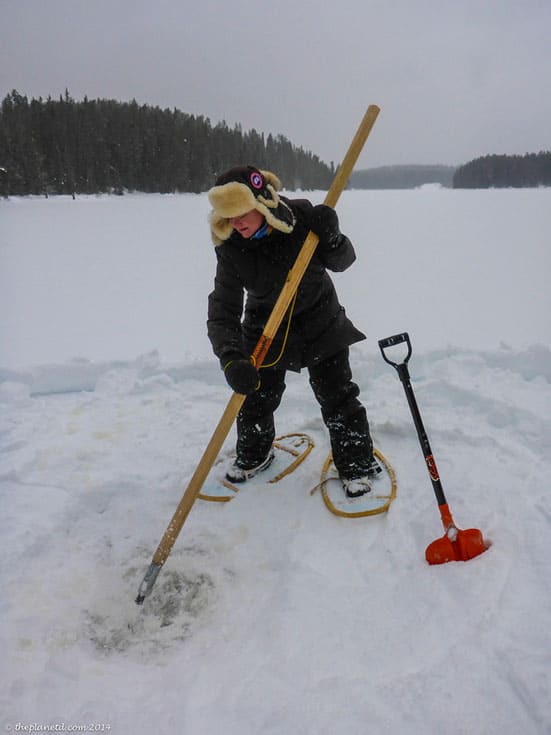
We didn’t carry water with us on our winter expedition, we got our water from the lake.
But we couldn’t just go and scoop it out of the lake, we had to work for it. We broke a hole in the ice (sometimes as thick as two feet) large enough to fit a large pot and collected the water that was still unfrozen below the surface. All water was boiled.
There is also a lot of prep that goes into the tent maintenance: We shovelled snow on top of the tent flaps to hold tent down if there were high winds. We set out anchors by burying logs in snow and tied the tent down to the anchors.
Laying boughs took a lot of work to get it just right. As the week went on, we discovered just how warm the boughs kept us, so our bed of boughs became thicker and thicker each night!
Evening – Inside the Tent
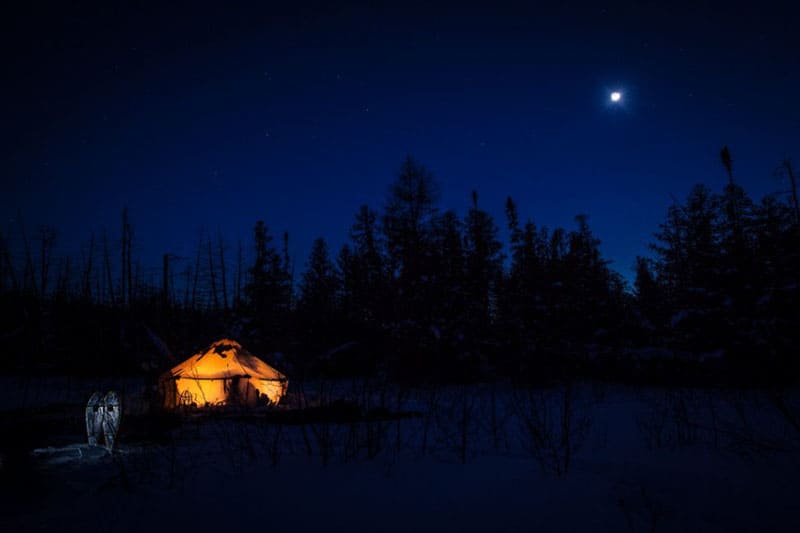
6:30 – move inside and hang wet clothes and gear from the day on a clothesline strung up on the roof of the tent. Everything that was remotely wet was hung up to dry. Moccasins, snow pants, sweaty under clothing, hats and gloves. Everything goes up in the middle of the tent.
Clothes
We didn’t bring many clothes with us because we wore the same thing each day.
- I just changed my base layer during the trip.
- All our outer layers remained the same, and we had three base layers with us.
- Two light layers, 1 heavier layer, and halfway through, we changed in to fresh clothing to feel human again.
7:00 A delicious dinner that owner/guide Kielyn made for us each night. She rarely had two meals the same and they were always hearty and delicious. She even baked cookies and cake in that wood stove!
7:45 relax, talk, sing a song or two and have Dave Marrone read us a bedtime story.
8:00 settle into our sleeping areas. 7 of us all slept together in the tent in one big semi circle. We zipped up our sleeping bags and didn’t come out again until morning.
8:15 – We were usually sound asleep thinking of our 5:00 am wake up call. Dave and Kielyn stoked the fire all night long for us keeping it toasty warm inside the tent and were up at 4:30 boiling water for coffee and a half hour later we were up and at it, ready to do it all over again..
11 days in a row…
Would you take part in a winter expedition like Lure of the North now that you know what one day is like?
Read More
- Expeditions are Glamorous in Retrospect
- 8 Tips for Safe and Comfortable Winter Trekking
- 52 Things to do in Canada – For the Ultimate Adventures
- How to Pack for an Alaskan Cruise
The Lure of the North is located in Sudbury Ontario and they run Traditional Winter Camping Expeditions all winter long ranging from 3-day introductory courses to full on 11-day epic adventures. In the summer you can take courses with them to make your own moccasins and traditional winter camping gear. Flights to Sudbury leave daily on Porter Airlines from Billy Bishop Airport in Toronto.
SaveSave

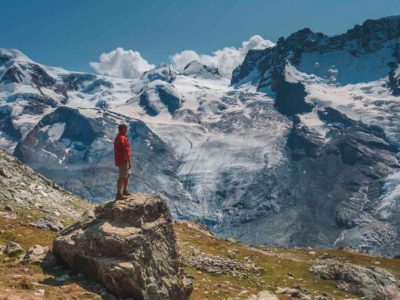
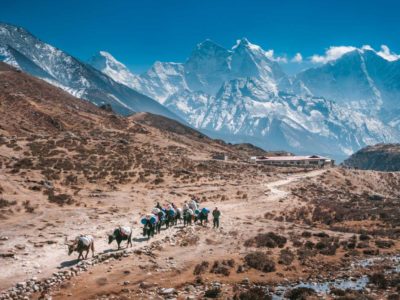
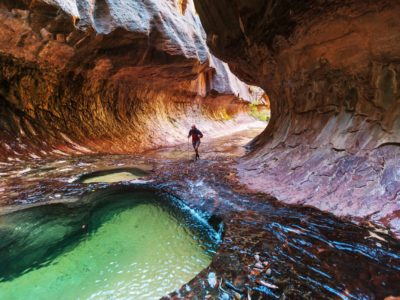
Last year I enjoyed my winter season at Alleppey and Thekkady Kerala and explored a lot enjoyed boathouse and other awesome places…
thank you for sharing this article…
This really echoes like that you people had a fantastic travel. I too love those snowfall, cold, and those night in cold places. thank you for sharing this awesome post.
Love the shots….Great ideas & scenery
Hmmm, I like the pictures that you shared here. I like winter season so much in comparison of other seasons. When I start reading your blog I can’t stop myself to finish it till the end because I love adventure. The way you described all details throughout of the day is fabulous. I think your blog is really very helpful for me and for everyone.
Wow! Thank you very much for the kind words. I’m glad you enjoyed the post. Hopefully you will enjoy a winter adventure soon too.
Perfect adventure! Everything about your experience is amazing. Never tried going out for an adventure in such harsh weather but I’d love to try it with some experts. Thanks for the brilliant ideas too.
Thanks Helen! Yes, it’s important to go with the experts. Dave and Kie live for this stuff, we’d be lost without them.
I love to cross-country ski in the winter, but you will usually find me in a hot tub and a warm bed after skiing. I have camped a couple of nights in the cold before, but 11 days is crazy. I am sure it was beautiful though. Did you see any wildlife?
We didn’t see any wildlife can you believe it? Lots of tracks though. It’s amazing how wildlife can be there, but you don’t see a thing.
I don’t know if i’m jealous or not!
on one hand, very jealous! Snow, ice and cold are my favorite things but after being on a very cold vacation lately i can’t imagine living in tents OUT IN THE COLD…
Good job guys, great adventure!
Haha! I think that is how a lot of people feel. It’s an amazing accomplishment, but not for everyone. Even climbing mount kilimanjaro or EBC isn’t for everyone. But it seems that the more adventures you do, the more you want to add epic ones like this to the list. At least we were warm in our tents. Many expeditions are spent shivering inside nylon tents, the wood stove when traditional camping is amazing!
About ten years ago my wife and I went on a 7 day Alaskan cruise. My parents went on the same cruise last year and still can’t stop raving about it. I swore to my wife after the vacation that I was going to hike some glaciers.
As many of the married guys can probably attest, this was not something that was approved by the “family safety committee”. But, after almost a decade, I have managed to plan a trek up to the Juneau Icefield.
I found a touring company that provides the proper equipment and outerwear and get you on the glaciers up to three hours. There’s even a helicopter flight included so you can witness the beauty of the glaciers.
Wish me luck. If I get so much as a scratch on me, I will be restrained to my bed for years to come 😉
Robert Bruce
Travel Ambassador
Good for you! And Good luck Robert. Have an amazing tie. We flew over some glaciers when in Alaska and it is outstanding. Such beauty up there.
This is something that, right off the bat, I don’t think I would agree to doing, but I know that if I went through with an expedition like this I would feel IMMENSE pride that I did it! Well done!
You said it Emily, it’s not something that is at the top of everyone’s list, but when you do it, you’ll feel so amazing. Remember, you can always work your way up to it!
Sounds like an amazing adventure indeed! For sure some “What the heck am I doing here” moments along the way as well, but certainly a fantastic experience… Thanks for the comprehensive write-up!
Thank you Oliver. Have you had any travels that have given you those ‘what the whack am I doing here moments?’
I would have never thought of using tree branches as insulation. Awesome idea but wouldn’t that get terribly uncomfortable? Also, the first tent photo is gorgeous!
Thank you for the compliment. Actually the branches were very comfortable. We slept on foam therms rests and we brought an extra inflatable thermarest. It was extremely padded. We spent a lot of time places the boughs so that the thickest part of the needles were in our bedding area. We piled them quite high sticking the stems into the snow. Spruce needles are quite cushiony, actually far more than the hard snow. They also helped us walk around inside without our snowshoes creating a nice base on the floor.
It really does sound amazing. A lot of tough work, but amazing!
Exactly! Amazing indeed